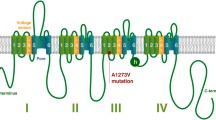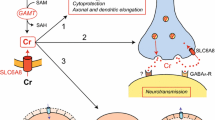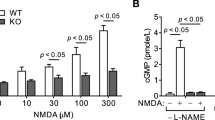Abstract
Previously we have shown that the temperature dependence of the sodium pump (Na+,K+-ATPase) is altered under different neuropathological conditions. In this study we compared temperature dependence of the Na+,K+-ATPase in the fronto-parietal cortex of CCK2 receptor-deficient (homo- and heterozygous) and normal (wild-type) mice. The Arrhenius plot for Na+,K+-ATPase from wild-type brain is non-linear with a breakpoint at 20.3 ± 0.4°C. In case of the brain cell membrane of CCK2 receptor-deficient mice (homo- and heterozygous) the breakpoint on Arrhenius plot was detected at 26.0 ± 1.1°C and 25.4 ± 0.4°C, respectively. The shift of the breakpoint on the Arrhenius plot established in CCK2 receptor-deficiency as well as in case of some other pathological conditions confirms that such kind of alteration in the Na+,K+-ATPase temperature dependence is likely related to the homeostatic adjustment of altered function of the sodium pump.

Similar content being viewed by others
References
Skou JC (1965) Enzymatic basis for active transport of Na+ and K+ across cell membrane. Physiol Rev 45:596–617
Xie Z, Askari A (2002) Na(+)/K(+)-ATPase as a signal transducer. Eur J Biochem 269(10):2434–2439
Kimelberg HK, Papahadjopoulos D (1974) Effects of phospholipid acyl chain fluidity, phase transitions, and cholesterol on (Na++K+)-stimulated adenosine triphosphatase. J Biol Chem 249:1071–1080
Therien AG, Blostein R (2000) Mechanisms of sodium pump regulation. Am J Physiol Cell Physiol 279:C541–C566
Cornelius F, Mahmmoud YA, Christensen HR (2001) Modulation of Na, K-ATPase by associated small transmembrane regulatory proteins and by lipids. J Bioenerg Biomembr 33(5):415–423
Harikumar KG, Pinon DI, Wessels WS et al (2004) Measurement of intermolecular distances for the natural agonist Peptide docked at the cholecystokinin receptor expressed in situ using fluorescence resonance energy transfer. Mol Pharmacol 65(1):28–35
Stekhoven FS, Bonting SL (1981) Transport adenosine triphosphatases: properties and functions. Physiol Rev 61:1–76
Maxfield FR, Tabas I (2005) Role of cholesterol and lipid organization in disease. Nature 438(7068):612–621
Escribá PV, Wedegaertner PB, Goñi FM et al (2007) Lipid-protein interactions in GPCR-associated signaling. Biochim Biophys Acta 1768(4):836–852
Esmann M, Skou JC (1988) Temperature-dependencies of various catalytic activities of membrane-bound Na+/K+ -ATPase from ox brain, ox kidney and shark rectal gland and of C12E8-solubilized shark Na+/K+ -ATPase. Biochim Biophys Acta 20 944(3):344–350
Boldyrev AA (1988) Characteristics of temperature dependence of Na, K-ATPase. Ukr Biokhim Zh 60(4):96–102
Salum TT, Tsil’mer K, Vikhalemm TE (1989) Features of temperature dependence of the Na+,K+ -ATPase reaction in normal and tumorous brain tissue. Ukr Biokhim Zh 61(4):65–69
Kairane C, Roots K, Uusma T et al (2002) Regulation of the frontocortical sodium pump by Na+ in Alzheimer’s disease: difference from the age-matched control but similarity to the rat model. FEBS Lett 531(2):241–244
Noble F, Wank SA, Crawley JN et al (1999) International Union of Pharmacology XXI. Structure, distribution, and functions of cholecystokinin receptors. Pharmacol Rev 51:745–781
McDonald IM (2001) CCK2 receptor antagonists. Exp Opin Ther Patents 11:445–462
Xiao ZL, Andrada MJ, Biancani P et al (2002) Reactive oxygen species (H(2)O(2)): effects on the gallbladder muscle of guinea pigs. Am J Physiol Gastrointest Liver Physiol 282(2):G300–G306
Roots K, Kairane C, Salum T et al (2006) Very low levels of cholecystokinin octapeptide activate Na-pump in the cerebral cortex of CCK2 receptor-deficient mice. Int J Dev Neurosci 24(6):395–400
Kurrikoff K, Kõks S, Matsui T et al (2004) Deletion of the CCK2 receptor gene reduces mechanical sensitivity and abolishes the development of hyperalgesia in mononeuropathic mice. Eur J Neurosci 20(6):1577–1586
Nagata A, Ito M, Iwata N et al (1996) G protein-coupled cholecystokinin-B/gastrin receptors are responsible for physiological cell growth of the stomach mucosa in vivo. Proc Natl Acad Sci USA 93(21):11825–11830
Karelson E, Zilmer M, Tähepõld L (1985) Prostaglandin E2 as a lipophilic modulator of Na-pump. Quest Med Chem (Russ.) 31:84–87
Lowry OH, Rosebrough NJ, Farr AL et al (1951) Protein measurement with the Folin phenol reagent. J Biol Chem 193(1):265–275
Roots K, Kõks S, Kairane C et al (2003) Na-pump kinetic properties are differently altered in the brain regions of the cholecystokinin2 receptor-deficient mice. Ann N Y Acad Sci 986:644–645
Dobrota D, Matejovicova M, Kurella EG et al (1999) Na/K-ATPase under oxidative stress: molecular mechanisms of injury. Cell Mol Neurobiol 19(1):141–149
Kurella EG, Tyulina OV, Boldyrev AA (1999) Oxidative resistance of Na/K-ATPase. Cell Mol Neurobiol 19(1):133–140
Valko M, Leibfritz D, Moncol J et al (2007) Free radicals and antioxidants in normal physiological functions and human disease. Int J Biochem Cell Biol 39(1):44–84
Yang Y, Sharma R, Sharma A et al (2003) Lipid peroxidation and cell cycle signaling: 4-hydroxynonenal, a key molecule in stress mediated signaling. Acta Biochim Pol 50:319
Marnett LJ (2002) Oxy radicals, lipid peroxidation and DNA damage. Toxicology 181–182:219–222
Horoz M, Bolukbas C, Bolukbas FF et al (2006) Oxidative stress in hepatitis C infected end stage renal disease subjects. BMC Infect Dis 6:114. doi:10.1186/1471-2334-6-114
Karelson E, Bogdanovic N, Garlind A et al (2001) The cerebrocortical areas in normal brain aging and in Alzheimer’s disease: noticeable differences in the lipid peroxidation level and in antioxidant defence. Neurochem Res 26:353–361
Johannsson A, Smith GA, Metcalfe JC (1981) The effect of bilayer thickness on the activity of (Na++K+)ATPase. Biochim Biophys Acta 641:416–421
Cornelius F (2008) Cholesterol-dependent interaction of polyunsaturated phospholipids with Na, K-ATPase. Biochemistry 47(6):1652–1658
Bystriansky JS, Ballantyne JS (2007) Gill Na+ -K+ -ATPase activity correlates with basolateral membrane lipid composition in seawater- but not freshwater-acclimated Arctic char (Salvelinus alpinus). Am J Physiol Regul Integr Comp Physiol 292(2):R1043–R1051
Esmann M, Marsh D (2006) Lipid-protein interactions with the Na, K-ATPase. Chem Phys Lipids 141(1–2):94–104
Xiao ZL, Chen Q, Amaral J et al (1999) CCK receptor dysfunction in muscle membranes from human gallbladders with cholesterol stones. Am J Physiol 276(6 Pt 1):G1401–G1407
Acknowledgments
This work was supported by grant No. 8259 from the Estonian Science Foundation, by targeted financing from Ministry of Education and Science of Estonia (SF0180105s08) and by European Union through the European Regional development Fund.
Author information
Authors and Affiliations
Corresponding author
Rights and permissions
About this article
Cite this article
Salum, T., Kõks, S., Kairane, C. et al. Temperature Dependence of the Sodium Pump is Altered in the Cerebral Cortex of CCK2 Receptor-Deficient Mice. Neurochem Res 35, 688–692 (2010). https://doi.org/10.1007/s11064-009-0119-1
Accepted:
Published:
Issue Date:
DOI: https://doi.org/10.1007/s11064-009-0119-1




